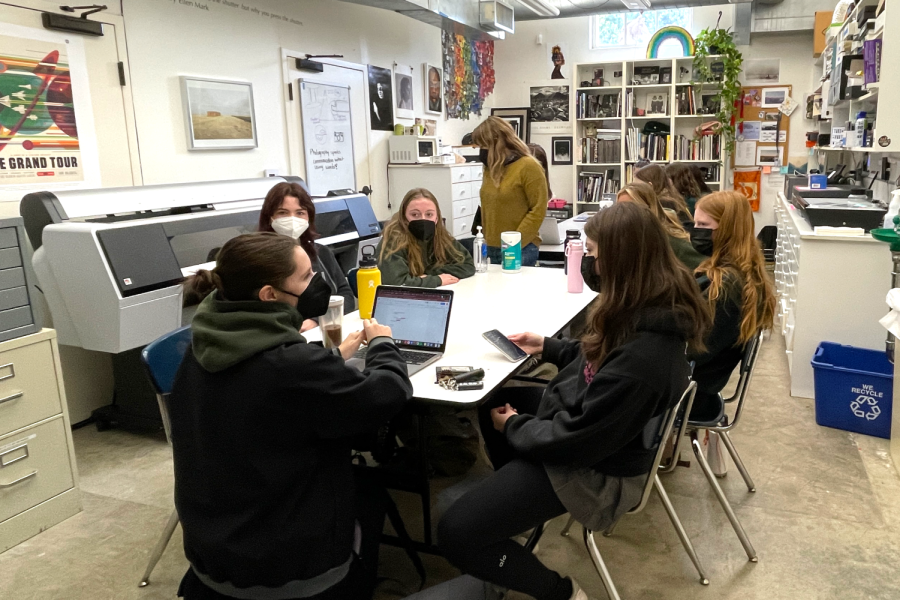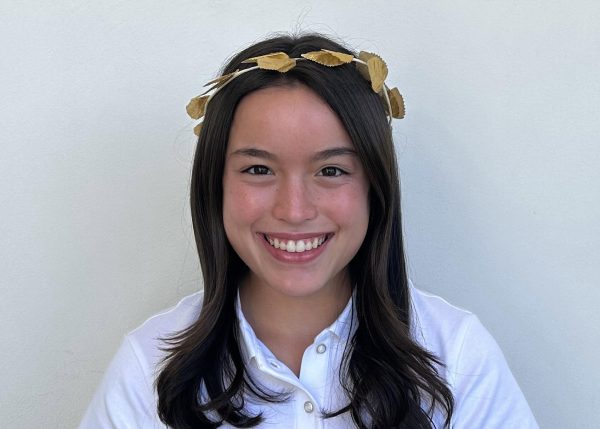‘A place where every single art has the ability to shine’: Archer Council of Artists highlights creativity in community
Photo credit: Audrey Chang
Upper school students split up into groups based on their particular art disciplines and interests to brainstorm ideas for the Visual Arts Festival. The ACA had their first meeting of the second semester on Jan. 12 in the photography room during lunch.
January 21, 2022
In response to a collective feeling that the arts are often underrepresented at Archer, a group of 18 upper school students have come together to form the Archer Council of Artists. This group aims to recognize, promote and inform students about art and creativity within the Archer community.
Junior Cira Mizel started the Archer Council of Artists this year as a program to foster and highlight student artistry in Archer’s art programs, whether it be recognizing the work of individual students or helping to promote other art clubs and groups around campus. The council had their first meeting on Dec. 8 and meets weekly on Wednesdays.
“The main purpose [of ACA] is really to highlight and bring attention to the arts within Archer and what our peers have been doing along those lines. We are also — I know Archer uses this term a lot — a big sister resource for other arts groups,” Mizel said. “To be watching this really come to life and watching other people get so invested in it is really amazing.”
Leaders of ACA describe their mission at Archer as recognizing artwork in the local community, emphasizing their role as a resource to support younger students and other groups on campus.
“I’m excited to hopefully get to work with some younger artists and try to help to inspire and help get younger students excited and involved,” tactile arts director of ACA Georgia Ehrlich (’23) said. “I had so many different mentors and older influences when I was younger, and they were extremely helpful in pushing forth my artistic journey.”
Arts teacher Marya Alford is the faculty advisor for ACA, and her role is to guide students in the program — to help them actualize their ideas and support their goals.
“It’s a way to amplify the arts at Archer and what students are doing inside and outside of classes, create new conversations and dialogue and showcase more work than the teachers are able to showcase throughout the year,” Alford said. “I’m excited that there’s going to be more acknowledgement and more artwork being seen and heard.”
During their first meeting, members of ACA discussed their long-term goals for the school year, beginning with short-term projects. ACA partnered with student council to host a Visual Arts Fair on Jan. 21. This project furthered ACA’s mission of having a community where every piece of art has the opportunity to be recognized and appreciated.
“We want interest in arts and the fact that there is such a big group of students who are so invested in the arts and so invested in this startup community that has so much potential really adds to what we’re excited about,” dance director of ACA Cara Banks (’23) said. “There’s going to be so many great ideas and so many different points of view … just creating a place where every single art has the ability to shine.”
Of the 18 students who participate in ACA, five of them hold leadership positions. In addition to Mizel’s position as visual arts director and founder of ACA, there are also opportunities for students to hold leadership positions such as directors of music, theater, dance, ceramics or tactile arts. During meetings, members divide into groups based on their art focus, work on individual projects and begin outreach to encourage community involvement.
“We have those different disciplines not to be exclusionary, but just because people know most about their area of expertise,” Mizel said. “I know a lot about visual arts, but I can’t really say the same about photography or film and TV, which is why we have them separated … to work within those disciplines, and then we come back together to still be one cohesive group.”
Another focus for members is to integrate the arts into Archer’s main culture and have the arts at Archer be displayed in the local community as well as outside of Archer.
“I have always loved the Archer Arts program and felt like it was underrepresented as the face of the school. I think it’s a huge part of the Archer identity, and we have really, really wonderful teachers and art programs,” Ehrlich said. “I just wanted to be a voice to highlight those programs for the rest of the school.”
Art has always been very meaningful to Mizel and, through ACA, she hopes it can be as big a part of Archer as it is for her.
“I’ve been a part of the whole world of art since I was really young because my mom is an artist — it’s always been a really big part of my life,” Mizel said. “I was so shocked and a bit disappointed when I first came to Archer and saw that it wasn’t as big to the community as art has always been for me, which is why I decided to start ACA because I wanted my love of art to be able to be other people’s love of art, even if they are not in an art class themselves.”
Students in ACA appreciated learning about new art forms other than what they have explored in their structured art classes at Archer. At their first meeting, members heard from representatives of each art department and began brainstorming how to increase awareness of various art disciplines at Archer.
“I learned so much in the one meeting about other groups … that’s even a microscopic level that we want to reach to the whole school where everybody knows what’s going on,” Banks said. “Even the fact that I’m involved in the arts and I had no idea what was going on with other arts, I think says a lot and shows the importance of ACA and why Cira started it.”
ACA utilizes representatives from every art department to consistently commit to showcasing a diverse range of artwork.
“As far as I know, we haven’t had something like this before,” Alford said. “There’s been clubs and things like that, but this is the first time that it’s been a more serious nature and a more dedicated nature.”
Originally, the idea for ACA was similar to the Athletic Leadership Council because students enjoyed having a council run by student representatives for athletics and felt the arts should be represented similarly in this way as well. Students feel like the arts should be equally highlighted in the Archer community as STEM because of large amount of student support.
“I feel like there’s a very STEM-oriented narrative about Archer, and I want that to change and I want people to see Archer is an amazing, vibrant school of just art and color all around,” Mizel said. “I think that’s my dream is just getting to watch as [ACA] continues on and it’s something that, sure I started, but it grows with Archer.”










Nicole • Jan 22, 2022 at 9:54 am
Wow! So impressive uniting and expanding Archer’s art community and fostering more leadership opportunities. Congratulations to all the girls behind ACA! Great reporting, Audrey!